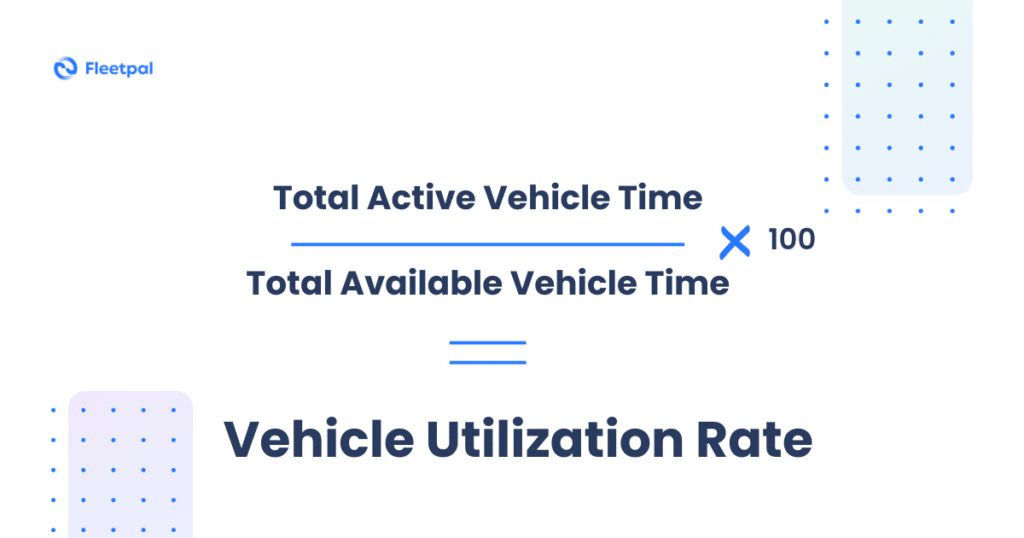Managing a fleet of vehicles efficiently is a complex task that requires an in-depth understanding of various performance metrics and key performance indicators.
One crucial metric in fleet management is the Vehicle Utilization Rate (VUR), which provides valuable insights into how effectively your fleet assets are being utilized.
In this article, we will delve into the concept of VUR to answer the following:
- What is vehicle utilization rate?
- Why this metric is important
- How to calculate your fleet’s vehicle utilization rate
What is vehicle utilization rate?
As noted above, vehicle utilization, often referred to as Vehicle Utilization Rate, is an essential metric in fleet management and logistics. It ultimately impacts the overall fleet utilization of your company and falls under the cageory of key fleet metrics and KPIs to monitor.
In essence, vehicle utilization answers the question of how much time a truck or another type of vehicle spends actively engaged in revenue-generating activities compared to its total available time.
A higher VUR indicates that a vehicle is being used more effectively, which is usually a desirable outcome in fleet management. Conversely, a lower VUR suggests that there may be room for improvement in optimizing vehicle usage, reducing downtime, and increasing productivity.
But how do you calculate the Vehicle Utilization Rate of your fleet assets?
How to calculate Vehicle Utilization Rate
Calculating VUR is simple.
All you have to do is use the following vehicle utilization formula:

To be able to effectively use this formula, you’ll need to have the following information:
Active Vehicle Time – This refers to the period during which a vehicle is actively involved in tasks that contribute to the organization’s revenue or mission. For example, in a delivery fleet, active time includes time spent on deliveries, pickups, or service calls.
Total Available Vehicle Time – This is the total amount of time a vehicle is theoretically available for use. It typically includes 24 hours a day, 7 days a week, adjusted for scheduled maintenance, repairs, refueling, and any other periods when the vehicle is not actively engaged in revenue-generating activities.
Keep in mind that Vehicle Utilization Rate is expressed as a percentage. Don’t forget to multiply the result by 100.
As mentioned above, the higher VUR, the better. Noticing a low Vehicle Utilization Rate may be a strong indicator that your fleet can be optimized further.
Why keeping track of vehicle utilization rate is important
While achieving absolute 100% vehicle utilization might be challenging, your utilization rate serves as a valuable tool for pinpointing any surplus capacity within your fleet.
Efficient vehicle utilization can lead to cost savings, improved productivity, enhanced customer service, and better decision-making regarding fleet size and maintenance schedules.
It is a must-have piece of information for any organization that relies on vehicles for their operations, including transportation and logistics companies, delivery services, construction firms, and more.
Let’s take a deeper look into the benefits of monitoring your fleet’s Vehicle Utilization Rate.
Cost reduction
Understanding and optimizing Vehicle Utilization Rate can lead to reduced operational costs. When vehicles are utilized effectively, you can minimize unnecessary fuel consumption, maintenance expenses, and depreciation, ultimately saving money.
Improved productivity
Higher utilization rates indicate that your fleet is working at its full potential. This leads to increased productivity as more jobs are completed in less time, allowing you to serve more customers.
Enhanced customer service
Fleet vehicles that are readily available can respond quickly to customer demands, leading to improved customer satisfaction. Timely deliveries and service appointments are more likely when vehicles are well-utilized.
This ultimately results in a boost in brand reputation and more loyal customers and partnerships.
Fleet right-sizing
By tracking VUR, you can identify underutilized vehicles in your fleet. This information allows you to right-size your fleet, selling or retiring excess vehicles and potentially avoiding the unnecessary purchase of new ones.
Compliance
In some industries, compliance with regulations related to vehicle utilization is mandatory. Monitoring utilization ensures you meet these requirements.
For example, many areas have strict emissions standards that vehicles must meet. If your fleet is underutilized, it may result in vehicles idling or operating inefficiently, leading to higher emissions. Maintaining an optimal utilization rate can help you meet emissions standards.
Maintenance and repairs
In addition, Vehicle Utilization Rate helps you schedule maintenance and repairs more efficiently, reducing downtime and the risk of unexpected breakdowns.
For instance, vehicles that sit idle for extended periods are more prone to mechanical issues due to inactivity. Regular utilization reduces the risk of components deteriorating or becoming damaged from disuse, thereby minimizing unplanned downtime.
Final thoughts
In the world of fleet management, optimizing your Vehicle Utilization Rate is a key strategy to enhance the performance of your fleet and meet your objectives.
We highly recommend actively tracking this metric as part of your fleet maintenance routine. Get access to all the data you need with the help of fleet maintenance software like Fleetpal.
If you’re ready to get started, get in touch with our sales team, and let us show you how Fleetpal can make a difference.
